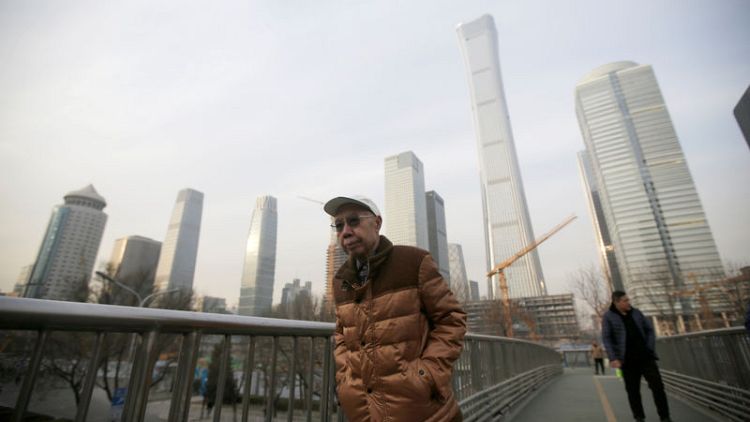BEIJING (Reuters) - New bank loans in China are expected to fall in February from a record the previous month, but the drop was likely due to seasonal factors as policymakers continue to press lenders to help cash-strapped companies, a Reuters poll showed.
Analysts say China needs to reverse weak credit growth to reduce the chance of a sharper economic slowdown this year, but investors are worried about a further jump in corporate debt and the risk to banks as they relax their lending standards.
Chinese banks likely extended 975 billion yuan ($145.37 billion) in net new loans in February, a median estimate in a Reuters survey of 26 economists showed.
That would be down sharply from a record 3.23 trillion yuan in January, when several other key credit gauges also picked up modestly in response to the central bank's policy easing.
But the forecast figure would still be about 16 percent higher than a year earlier.
A pull-back in February's lending is widely expected as Chinese banks tend to front-load loans at the beginning of the year to get higher-quality customers and win market share.
Economists at the Bank of Communications expect demand for credit will gradually increase this year as a flurry of policy stimulus measures start to work their way through the economy.
Premier Li Keqiang told parliament on Tuesday that monetary policy would be "neither too tight nor too loose" and that the government would not resort to a flood of liquidity.
Growth targets for M2 money supply, which includes cash in circulation and deposits, and total social financing this year would be in line with nominal GDP growth.
Broad M2 money supply and annual outstanding yuan loan growth were seen rising 8.4 percent and 13.4 percent respectively in February from a year earlier, both unchanged from the pace January, according to the poll.
TSF, a broad measure of credit and liquidity in the economy, was estimated to have shrunk to 1.45 trillion yuan in February, compared with 4.64 trillion yuan in January.
TSF includes off-balance sheet forms of financing that exist outside the conventional bank lending system, such as initial public offerings, loans from trust companies and bond sales.
POLICY EASING SEEN ON TRACK
China's economic growth slowed to 6.6 percent last year -- a 28-year low -- from 6.8 percent in 2018, weighed down by higher borrowing rates and tighter credit conditions and by a trade war with the United States.
Growth is expected to cool to around 6.2 percent this year, according to Reuters polls, with most economists expecting a rocky first half before conditions begin to stabilise around mid-year.
Sourced have told Reuters the central bank is not yet ready to cut benchmark interest rates to spur the slowing economy, but is likely to cut market-based rates and further lower banks' reserve ratios (RRR) to boost credit growth and reduce firms' borrowing costs.
Chinese officials have reiterated China will not resort to "flood-like" stimulus like that unleashed in past downturns, though a spate of weak data showed the world's second-largest economy is still losing steam.
Premier Li also said on Tuesday that China will push for market-based reforms to lower the real interest rate level.
The government said this week that it has set a target for large state-owned banks to increase their lending to smaller companies by 30 percent this year.
Analysts note there is a time lag before a jump in lending will translate into growth, suggesting business conditions may get worse before they get better. And, there is a risk that more firms are borrowing merely to refinance existing debt, rather than for fresh investment needed to fuel an economic turnaround.
"Indeed, while there are signs that credit growth is starting to bottom out thanks to policy support, the usual lags mean that last year's slowdown in lending will probably continue to weigh on economic activity until at least the middle of this year," Julian Evans-Pritchard, senior China economist at Capital Economics, wrote in a note.
(Reporting by Lusha Zhang and Kevin Yao; Editing by Kim Coghill)



